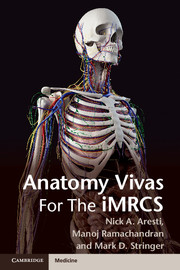Introduction
Published online by Cambridge University Press: 05 November 2012
Summary
The MRCS (Membership of the Royal College of Surgeons) exam has undergone drastic changes in recent years, one of the most significant being the way in which anatomy is examined. As a candidate sitting the exam it is essential that you spend the necessary time learning your anatomy in sufficient detail not only to pass the exam, but also to continue your surgical training. In the process it is vital that you understand the exam structure and adapt your learning style accordingly.
Although this book has been designed primarily as a revision guide and a learning tool, it has been put together in a manner that is very similar to the structure of the anatomy vivas in the exam. The questions are clinically orientated and are based around themes and clinical scenarios. Photographs of cadavers and prosections, simple diagrams, radiography and photographs of actors are all incorporated into the text to ensure the questions are as similar as possible to the questions in the actual exam.
Most of the topics which have been examined in the new exam system are covered in significant detail in this book. It is no secret that the College is only able to write so many questions and so there is a lot of repetition. Learning the contents of this book will therefore aid your performance in the exam. You must however be wary that you may well be the subject of a completely new anatomy viva station, so do not get lulled into a false sense of security and only learn the topics that have come up in the past.
Use this book in combination with anatomy textbooks and video tutorials. You may never have been examined in the format employed in the exam, particularly on basic science topics. In preparation therefore, practice reciting your answers out loud to colleagues, friends, family or even pets if you have to.
- Type
- Chapter
- Information
- Anatomy Vivas for the Intercollegiate MRCS , pp. 1 - 3Publisher: Cambridge University PressPrint publication year: 2012



